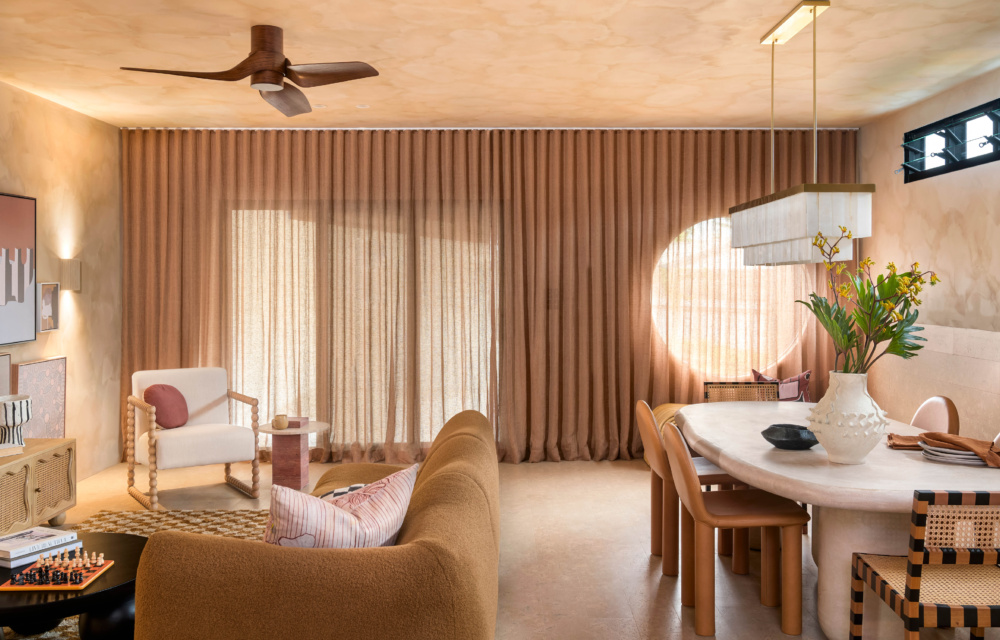How A Stylist Turned This ‘Crumbling’ Warehouse Into His Unique Home
Interiors
Hipwell Haus is a circa 1920s warehouse turned two-bedroom family home.
The new walls are covered in limewash and venetian plaster in ode to the building’s original textures.
Tim’s art collection of limited-edition prints by Australian arts add pops of colour throughout.
Arch Leather Dining Chair by ELLISON STUDIOS. Curtains by DIY Blinds.
Cork flooring adds warmth to the ground-floor living spaces.
The marbled and rich burgundy hues of the Breccia Rosso Granite set the tone for the interiors.
The new kitchen.
Polyetc Rojo Walnut on joinery. Cabinetry by Vista Kitchens.
Terracotta breeze blocks create the base of the unique island bench.
‘We needed to create an internal staircase, as the only exiting access to the upper floor was a rickety old external staircase — meaning you had to go outside to get upstairs!’ Tim explains.
The only visible sections of the original building are the beautiful texture of the 100-year-old exposed brick walls in some rooms.
The lounge room.
Glossy red tiles create a moody feel in the powder room.
Baths and vanities by Highgrove Bathrooms.
Tim mixed brass, bronze and copper tones in the tapware and hardware.
The ensuite.
Basins by Nood Co.
Bellmore Plank by Havwoods features in the bedrooms upstairs.
Pepé Side Table by ELLISON STUDIOS.
Lighting by Beacon Lighting.
Hipwell Haus lived many lives before interior stylist Tim Neve snapped it up in March 2022.
It was originally built as a general store for storekeeper R.W. Hipwell — whose name still graces the 1926 facade. In the 1960s, it reportedly served as a tailor shop, and in more recent years, Newcastle locals talk about ‘the time a storm tore off the roof’.
When Tim saw it on the market, the original art deco structure had been stripped back to the hardwood frame, leaving no services like water or electricity connected to the property.
‘The warehouse space was literally a dirt floor — weeds and all,’ Tim says.
‘But all I could see was potential. The bones were impressive: expansive open-plan spaces, soaring ceilings, and large windows that flooded the interiors with light.
‘To me, it wasn’t a crumbling relic but the ultimate blank canvas. And for a 100-year-old building, it actually passed the structural building report with flying colours.’
Immediately after the settlement, Tim poured a concrete slab over the muddy floor and got to work reimagining the property as a home for himself and his son, Honne.
‘Drawing inspiration from the building’s visual remnants, I envisioned a design that celebrated its industrial roots — exposed brick, weathered textures, and timeless character,’ he adds.
In the ground-floor living spaces, cork floors are paired with lime-washed walls and venetian plaster as an updated way to maintain the warehouse’s original patina and old-world charm.
Slab of burgundy granite and terracotta breeze blocks make for an intriguing island bench at the heart of the kitchen, while the new walnut veneer joinery ties in perfectly with the new dark timber flooring upstairs.
‘All of the spaces now radiate such ‘feel good’ vibes. Every single person literally gasps as they enter each room for the first time and take it all in, but then quickly settle into the warm embrace of the home,’ Tim says.
Two years into the renovation, the decrepit warehouse has become a creative two-bedroom home that feels like an entirely new build — with all new internal linings, flooring, windows, electrical and plumbing.
‘It seemed like an endless maze of spaces, so I tackled it room by room. There were plenty of times when I thought I just would never get through it all,’ he adds.
It’s been a true labour of love, and Tim’s amassed quite a following online for the Hipwell Haus’ dramatic before and after shots!
But he says it was all worth it: ‘I’m so excited to have refreshed the spaces so they can live on for another 100 years.’

